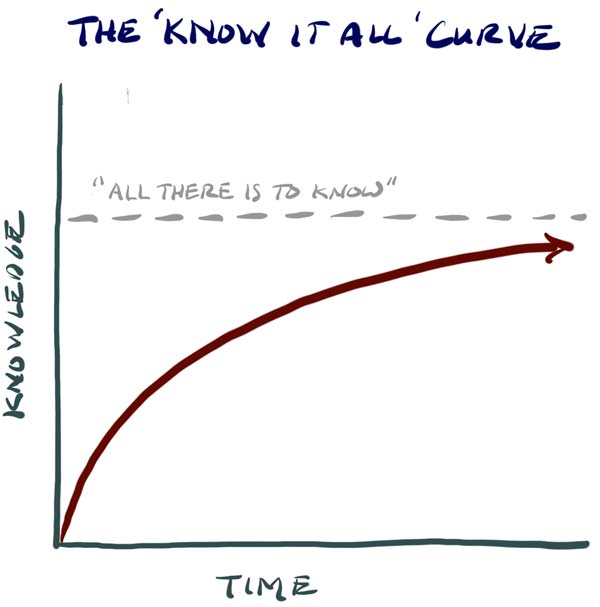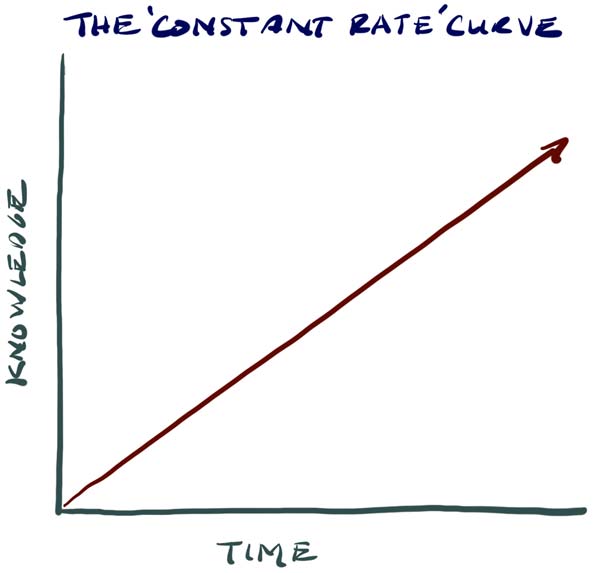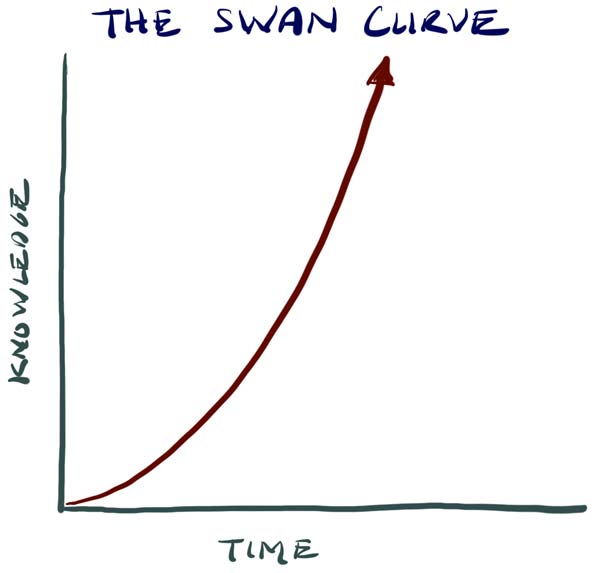Rethink Learning

Up until this point, we have only discussed ‘WHAT’ great leaders learn: How to add value. We now need to talk about how you are going to learn it, faster and faster, forever. To do that, we need to talk a little bit about learning curves, and how to make yours keep getting steeper and steeper.
If we assume that the you are trying to improve your skills as fast as you can, your learning curve will probably come in one of three shapes, ‘The Know It All Curve,’ ‘The Constant Rate Curve,’ or ‘The Swan Curve.’ The Know It All Curve is the most common, and The Swan Curve by far the least. But that doesn’t mean the Swan Curve is limited to some small group of super geniuses. All you need to do to bend your learning trajectory form one curve to another is two subtle changes in the way you think about learning itself.
The Know It All Curve
The Know It All Curve is the inevitable result of making the assumption that the subject you are learning is finite. When you are first exposed to a finite new subject all of it is new and it feels like you are learning very quickly. But over time you begin to master it. And as you get closer to knowing all of it, you run out of new things to learn. Your learning curve levels out and eventually you stop learning all together. When you are learning on the Know It All Curve, learning is like picking fruit from a tree. In the beginning, getting fruit it is very easy. But the more fruit you pick, the harder it is to get the next piece. And eventually you run out of fruit that you can reach.
Assuming that subjects are finite is the natural thing to do. Throughout our formal educations they all were. The schools you went to broke the knowledge that human kind has accumulated into finite subjects, subjects into finite textbooks, textbooks into finite chapters. Everything was grouped into manageable chunks that could be taught a tested. Once you had mastered the material that would be on the next test, you literally ‘knew it all.’ There was nothing left to study and your learning curve leveled off until you were introduced to the next chunk of subject matter. You weren’t thinking about this as it happened. You just subconsciously learned that subjects are finite because over and over again, it turned out to be true.
There is just one problem with assuming that subjects are finite. It’s not true. In the real world, where knowledge is not being spoon fed to you, there is no such thing as a finite subject.
While It would not be difficult to learn everything that a 7th grade world history text contains about the Roman Empire, thinking that you could actually know everything that happened during the Roman Empire is preposterous. It would be impossible to know even the smallest fraction of what happened in just the last ten seconds. History, even a small slice of it, is essentially infinite. As is Mathematics, Physics, Psychology... Everything is. Even if you could learn all of the Math that has ever been discovered, you would still have to learn all of the math that is yet to be discovered to run out of math to learn. That’s a lot of math. It’s just impossible to run out of new stuff to learn.
The Constant Rate Curve
The result of eliminating the false assumption that subjects are finite is The Constant Rate Curve. If subjects are infinite, your learning curve no longer has reason to level off. At least as long as the knowledge left to learn is still useful. (We’re really talking about learning the six basic actions, and no matter how good you get at any of them, it will still be incredibly useful to get better.) When you are learning along The Constant Rate Curve, your experience is more like packing fruit at a fruit processing plant than it is like picking fruit off a tree. As long as the fruit trucks coming in from the orchards, you can keep packing it up as fast as the conveyor belt can deliver it. The knowledge you are gaining is the fruit, and your teacher is the conveyor belt delivering it from the trucks. You are only limited by the rate at which your teacher (or teachers) can deliver you the knowledge.
But the Constant Rate Curve is limited by a second misconception about learning: that the rate at which we can learn is limited. This is true if you are totally dependent on learning from teachers. A teacher can only explain things so fast. And they can only explain what they know. And having multiple teachers explain multiple subjects to you at the same time just doesn’t work, at least not for me. Early in your learning process having a teacher can be a great benefit, but in the long run, as you learn more and more, the teacher becomes a bottleneck.
We actually learn the fastest when we are in a very information rich environment and can’t get what we want without learning more about what’s going on around us. What is the hardest thing you ever learned to do? I would argue it’s the same for all of us - learning to understand language and communicate ideas. How in the world did we do that? Nobody “taught” us. Somehow, we just figured out how to do it. Slowly at first, but each little bit we pieced together provided context that we could hook the next several little bits to. The more bits we accumulated, the faster we could absorb new bits. And the bigger the bits were that we could make sense of.
In order to learn anything, you need some prior knowledge to give it context. Learning is literally the act of connecting new information to knowledge that you already have. Turning it into something you “know.” If you don’t know how to count you have nothing to hook the concept of addition to. Without addition, how could multiplication make sense? Without multiplication, how could you learn algebra? I think you’d agree that learning algebra is a lot more complicated to learn than how to count to 100. But I bet learning to count to 100 took each of us much longer to figure out how to do. We had much less knowledge to support that learning. My point is that when you are trying to learn something, what you need more than anything else, is some prior knowledge that you can hook it on to. And the more knowledge you have, the faster you will learn. And when you are learning organically from your environment as we did when we were children learning to talk, the rate at which we learn is not constrained by how fast a teacher can teach. The more knowledge you have related to a subject you are trying to learn, the faster you can learn it.
Business is a complex, multiple discipline spanning activity. Math, psychology, geography, economics, technology, engineering, civics, ethics, graphic arts, physics, ergonomics... the number of subjects that can be useful in business is limitless. It makes an almost perfect environment for accelerated learning. The larger your database of knowledge is, and the more subjects that are in some way related to what you are doing in your role, the easier it will be for you to grasp the multiple discipline spanning, highly complex issues that the people at the top of your business are dealing with. And most of what is going on at the top of a large company is so complicated that it takes multiple experts, with complementary skill sets and knowledge bases to make sense of it all.
The Swan Curve
Being in a business surrounded by the complexity and mystery of what is going on around you – one of the big challenges in business is just keeping track of what’s happening – is very much like being an infant and trying to understand what language is. The difference is that when you and I were babies, we were EXTREMELY motivated to figure out what was going on and make sense of it. 99% of people in a business are a little bit interested, but certainly not desperately interested in figuring it all out. But if you are desperately interested, and you realize that every subject is infinite and infinitely interesting, and that there is no limit to the speed at which you can learn, something magical can happen. You start to ride the Swan Curve.
When you are riding the Swan Curve learning is no longer like picking fruit or packing it. It’s like being the tree. And the knowledge you are seeking is no longer fruit, it’s the leaves. If you were a tree, and you wanted more leaves, what would you need? Some more leaves. Those leaves are what you need to photosynthesize light and separate the carbon you need to grow from the carbon dioxide all around you. Scientists studying global warming were shocked to find that the oldest, largest trees in any forest grow the fastest, and the fastest by an enormous margin. The largest trees in a forest add the mass of an average size tree every single year. Every new leaf causes the tree to grow faster, and grow more leaves, which makes it grow faster still. It just happens too slow for us to notice. Kind of like learning.
In business you are a tree that is using its knowledge to glean more and more knowledge from everything that is going on around you. And the more knowledge you have, the faster you will gather more. I guarantee the CEO of the business you are working for is learning more, by orders of magnitude, than someone on their first day on the job. Especially when it comes to learning how to add value. Your first day probably is a day when you are having to learn lots of stuff. But it’s hard to convert the knowledge of where the bathroom is to value for a customer or the company’s shareholders. And it’s also not the kind of knowledge you can hook a lot of other value-added knowledge to. Meanwhile, the CEO in one three hour business review meeting, just learned that the logic that proves the $300 million underwriting loss in the auto warranty business is definitely a pricing problem and not a claims processing problem, that McKinsey Consulting has some great ideas on how to attract millennials into their technology department, and how the Treasurer generated $36 million in free cash flow by restructuring the special purpose funding vehicle that is being used to finance the expansion into China. All of these things may have been something the CEO knew nothing about before the meeting. But she knew a TON about things that were closely related them. And after the meeting she knew almost everything she needed to. After all, the people “teaching” her were the top experts in the world on those subjects. The very same people who were leading those efforts. And if she knew how to pick and develop top talent, the majority of them had been riding the Swan Curve themselves for years, maybe even decades.
Business can be a spectacular environment for learning if you are interested, motivated, and earn the right to the person that gets to ask all of the questions. So don’t pick fruit, and don’t pack fruit. Be the tree.
And then become an orchard.


